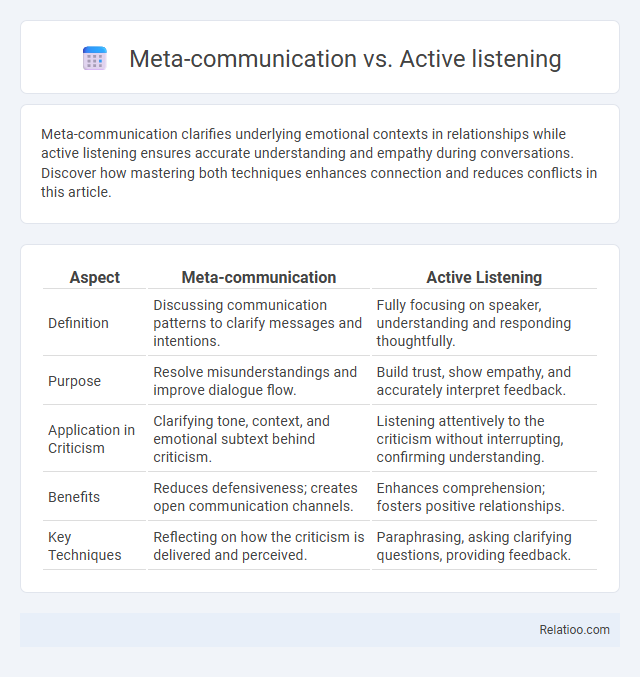Meta-communication clarifies underlying emotional contexts in relationships while active listening ensures accurate understanding and empathy during conversations. Discover how mastering both techniques enhances connection and reduces conflicts in this article.
Table of Comparison
| Aspect | Meta-communication | Active Listening |
|---|---|---|
| Definition | Discussing communication patterns to clarify messages and intentions. | Fully focusing on speaker, understanding and responding thoughtfully. |
| Purpose | Resolve misunderstandings and improve dialogue flow. | Build trust, show empathy, and accurately interpret feedback. |
| Application in Criticism | Clarifying tone, context, and emotional subtext behind criticism. | Listening attentively to the criticism without interrupting, confirming understanding. |
| Benefits | Reduces defensiveness; creates open communication channels. | Enhances comprehension; fosters positive relationships. |
| Key Techniques | Reflecting on how the criticism is delivered and perceived. | Paraphrasing, asking clarifying questions, providing feedback. |
Understanding Meta-communication: Definition and Importance
Meta-communication refers to the underlying messages and context conveyed through tone, body language, and non-verbal cues that shape the meaning of verbal communication. Understanding meta-communication is crucial for interpreting the true intent behind words, enhancing interpersonal interactions and preventing misunderstandings. In contrast, active listening emphasizes fully concentrating, understanding, and responding to spoken messages, while meta-communication covers the broader context beyond just the spoken content.
What Is Active Listening? Key Elements Explained
Active listening is a communication technique where You fully concentrate, understand, respond, and remember what is being said. Key elements include attentiveness, reflecting on the speaker's words, and providing feedback to confirm understanding. This approach supports meta-communication by clarifying underlying messages beyond the spoken words.
Meta-communication vs Active Listening: Core Differences
Meta-communication involves the underlying messages and context of communication, helping you interpret tone, intention, and emotions beyond spoken words. Active listening requires your focused attention and feedback to fully understand the speaker's message, emphasizing verbal and nonverbal cues. The core difference lies in meta-communication's role in decoding the communication framework, while active listening centers on engagement and responsiveness during the exchange.
How Meta-communication Enhances Conversation Clarity
Meta-communication enhances conversation clarity by enabling you to address the underlying meaning behind words, helping to resolve misunderstandings before they escalate. Unlike active listening, which focuses on fully understanding the speaker's message, meta-communication involves discussing how the conversation itself is happening, fostering transparency and mutual awareness. This approach improves interpersonal dynamics by clarifying intentions, emotions, and unspoken assumptions during communication.
The Role of Active Listening in Building Trust
Active listening plays a crucial role in building trust by fostering open exchange and empathy between communicators, enhancing mutual understanding beyond just the words spoken. Meta-communication, which involves discussing the communication process itself, complements active listening by clarifying intentions and ensuring messages are received as intended, reducing misunderstandings. Together, active listening and meta-communication create a foundation for deeper connection, enabling more effective relationship development and conflict resolution.
Practical Examples: Meta-communication in Real-Life Scenarios
Meta-communication involves discussing the way you communicate to clarify misunderstandings and improve dialogue, such as saying, "I feel like we're talking past each other, can we slow down?" Active listening requires fully focusing on the speaker, providing feedback, and reflecting emotions, exemplified when you nod, paraphrase, and ask open-ended questions during a conversation. Using meta-communication in real-life scenarios helps resolve conflicts efficiently by addressing communication styles directly, ensuring your message is clearly understood and promoting effective interaction.
Techniques to Improve Active Listening Skills
Active listening skills can be enhanced through techniques such as maintaining eye contact, providing verbal affirmations, and paraphrasing to confirm understanding. Meta-communication involves recognizing and addressing the underlying messages in your dialogue, which deepens your interpretative ability during conversations. Your communication improves significantly when combining active listening with meta-communication, allowing you to respond thoughtfully and reduce misunderstandings.
Integrating Meta-communication and Active Listening for Effective Dialogue
Integrating meta-communication with active listening enhances dialogue effectiveness by fostering mutual understanding and clarifying underlying messages. Meta-communication involves discussing the communication process itself, allowing participants to address tone, intent, and context, while active listening requires fully concentrating, understanding, and responding thoughtfully to the speaker. Combining these techniques promotes transparent, empathetic exchanges that reduce misunderstandings and build stronger interpersonal connections.
Common Barriers to Meta-communication and Active Listening
Common barriers to meta-communication and active listening include assumptions, emotional interference, and lack of clarity, which can distort your intended message and hinder mutual understanding. Distractions and prejudgments often prevent fully engaging in active listening, while fear of judgment or conflict can reduce openness in meta-communication. Overcoming these obstacles requires intentional focus on clarity, empathy, and reflective feedback to enhance interpersonal communication effectiveness.
Choosing the Right Approach: When to Use Meta-communication or Active Listening
Choosing the right communication approach depends on your goal: use meta-communication to clarify underlying messages and address misunderstandings directly, while active listening fosters empathy and understanding by fully engaging with the speaker's words and emotions. Meta-communication is effective in resolving conflicts or when you need to discuss the communication process itself, whereas active listening is ideal for building trust and encouraging open dialogue. Your ability to discern when to switch between these methods enhances interpersonal effectiveness and meaningful connection.

Infographic: Meta-communication vs Active listening
 relatioo.com
relatioo.com